Canon SX60 vs Panasonic FZ100
The Canon PowerShot SX60 HS and the Panasonic Lumix DMC-FZ100 are two digital cameras that were announced, respectively, in September 2014 and July 2010. Both the SX60 and the FZ100 are fixed lens compact cameras that are equipped with a 1/2.3-inch sensor. The Canon has a resolution of 14.2 megapixels, whereas the Panasonic provides 14 MP.
Below is an overview of the main specs of the two cameras as a starting point for the comparison.

Check SX60 offers at
ebay.com

Check FZ100 offers at
ebay.com
Going beyond this snapshot of core features and characteristics, what are the differences between the Canon PowerShot SX60 HS and the Panasonic Lumix DMC-FZ100? Which one should you buy? Read on to find out how these two cameras compare with respect to their body size, their imaging sensors, their shooting features, their input-output connections, and their reception by expert reviewers.
Body comparison
The physical size and weight of the Canon SX60 and the Panasonic FZ100 are illustrated in the side-by-side display below. The two cameras are presented according to their relative size. Three successive views from the front, the top, and the rear are shown. All width, height and depth measures are rounded to the nearest millimeter.
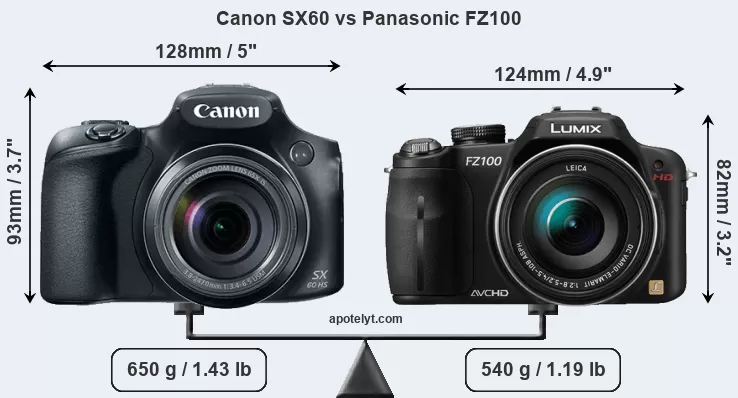
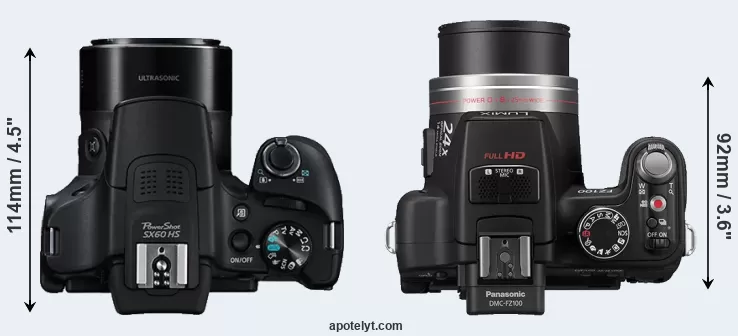
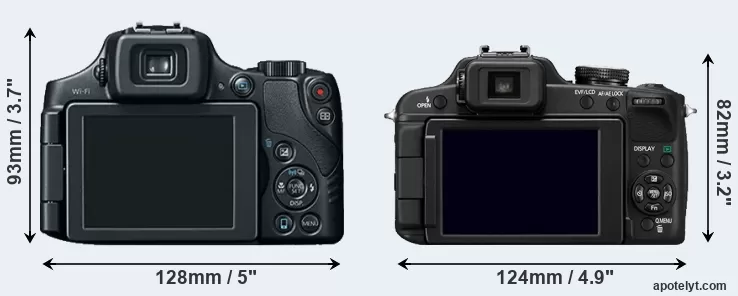
If the front view area (width x height) of the cameras is taken as an aggregate measure of their size, the Panasonic FZ100 is notably smaller (15 percent) than the Canon SX60. Moreover, the FZ100 is markedly lighter (17 percent) than the SX60. In this context, it is worth noting that neither the SX60 nor the FZ100 are weather-sealed.
Concerning battery life, the SX60 gets 340 shots out of its Canon NB-10L battery, while the FZ100 can take 410 images on a single charge of its Panasonic DMW-BMB9 power pack.
The table below summarizes the key physical specs of the two cameras alongside a broader set of comparators. If you want to switch the focus of the display and review another camera pair, you can move across to the CAM-parator tool and choose from the broad selection of possible camera comparisons there.

| Camera Model |
Camera Width |
Camera Height |
Camera Depth |
Camera Weight |
Battery Life |
Weather Sealing |
Camera Launch |
Launch Price (USD) |
Street Price |
||
|---|---|---|---|---|---|---|---|---|---|---|---|
| 1. | Canon SX60 | 128 mm | 93 mm | 114 mm | 650 g | 340 | n | Sep 2014 | 549 | ebay.com | |
| 2. | Panasonic FZ100 | 124 mm | 82 mm | 92 mm | 540 g | 410 | n | Jul 2010 | 499 | ebay.com | |
| 3. | Canon G1 X Mark II | 116 mm | 74 mm | 66 mm | 553 g | 240 | n | Feb 2014 | 799 | ebay.com | |
| 4. | Canon G15 | 107 mm | 76 mm | 40 mm | 352 g | 350 | n | Sep 2012 | 499 | ebay.com | |
| 5. | Canon G16 | 109 mm | 76 mm | 40 mm | 356 g | 360 | n | Aug 2013 | 549 | ebay.com | |
| 6. | Canon SX30 | 123 mm | 92 mm | 108 mm | 601 g | 370 | n | Sep 2010 | 429 | ebay.com | |
| 7. | Canon SX40 | 123 mm | 92 mm | 108 mm | 600 g | 380 | n | Sep 2011 | 429 | ebay.com | |
| 8. | Canon SX50 | 123 mm | 87 mm | 106 mm | 595 g | 315 | n | Sep 2012 | 429 | ebay.com | |
| 9. | Canon SX70 | 127 mm | 91 mm | 117 mm | 608 g | 325 | n | Sep 2018 | 549 | amazon.com | |
| 10. | Nikon P900 | 140 mm | 103 mm | 137 mm | 899 g | 360 | n | Mar 2015 | 599 | ebay.com | |
| 11. | Panasonic FZ150 | 124 mm | 82 mm | 92 mm | 528 g | 410 | n | Aug 2011 | 499 | ebay.com | |
| 12. | Panasonic FZ200 | 125 mm | 87 mm | 110 mm | 588 g | 540 | n | Jul 2012 | 599 | ebay.com | |
| 13. | Panasonic FZ300 | 132 mm | 92 mm | 117 mm | 691 g | 380 | Y | Jul 2015 | 599 | amazon.com | |
| 14. | Sony HX400V | 130 mm | 93 mm | 103 mm | 660 g | 300 | n | Feb 2014 | 499 | ebay.com | |
| Note: Measurements and pricing do not include easily detachable parts, such as add-on or interchangeable lenses or optional viewfinders. | |||||||||||
Any camera decision will naturally be influenced heavily by the price. The manufacturer’s suggested retail prices give an idea on the placement of the camera in the maker’s lineup and the broader market. The FZ100 was somewhat cheaper (by 9 percent) than the SX60 at launch, but both cameras fall into the same price category. Usually, retail prices stay at first close to the launch price, but after several months, discounts become available. Later in the product cycle and, in particular, when the replacement model is about to appear, further discounting and stock clearance sales often push the camera price considerably down.
Sensor comparison
The size of the imaging sensor is a crucial determinant of image quality. All other things equal, a large sensor will have larger individual pixel-units that offer better low-light sensitivity, wider dynamic range, and richer color-depth than smaller pixels in a sensor of the same technological generation. Moreover, a large sensor camera will give the photographer more control over depth-of-field in the image and, thus, the ability to better isolate a subject from the background. On the downside, larger sensors tend to be associated with larger, more expensive camera bodies and lenses.
Both cameras under consideration feature a 1/2.3-inch sensor and have a format factor (sometimes also referred to as "crop factor") of 5.6. Within the spectrum of camera sensors, this places the review cameras among the smaller-sensor digicams that favor affordability and compact design. Both cameras feature a native aspect ratio (sensor width to sensor height) of 4:3.
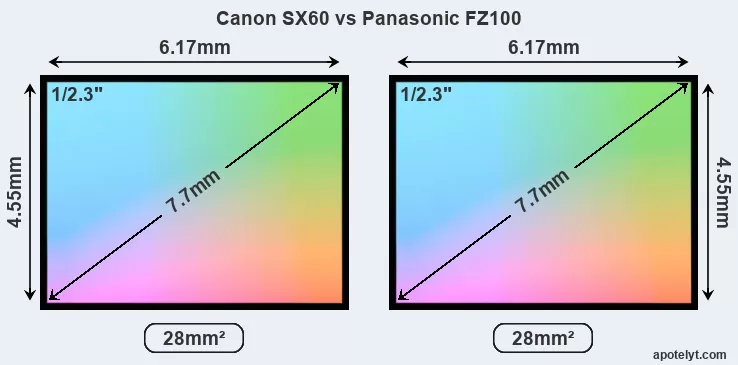
While the two cameras under review share the same sensor size, the SX60 offers a slightly higher resolution of 14.2 megapixels, compared with 14 MP of the FZ100. This megapixels advantage translates into a 7 percent gain in linear resolution. On the other hand, these sensor specs imply that the SX60 has a higher pixel density and a smaller size of the individual pixel (with a pixel pitch of 1.40μm versus 1.41μm for the FZ100). In this context, it should be noted, however, that the SX60 is much more recent (by 4 years and 1 month) than the FZ100, and its sensor will have benefitted from technological advances during this time that compensate for the smaller pixel size. Coming back to sensor resolution, it should be mentioned that neither of the two cameras has an anti-alias filter installed, so they are able to capture all the detail the sensor resolves.
The Canon PowerShot SX60 HS has a native sensitivity range from ISO 100 to ISO 3200, which can be extended to ISO 100-6400. The corresponding ISO settings for the Panasonic Lumix DMC-FZ100 are ISO 100 to ISO 1600, with the possibility to increase the ISO range to 100-6400.
In terms of underlying technology, the SX60 is build around a BSI-CMOS sensor, while the FZ100 uses a CMOS imager. Both cameras use a Bayer filter for capturing RGB colors on a square grid of photosensors. This arrangement is found in most digital cameras.
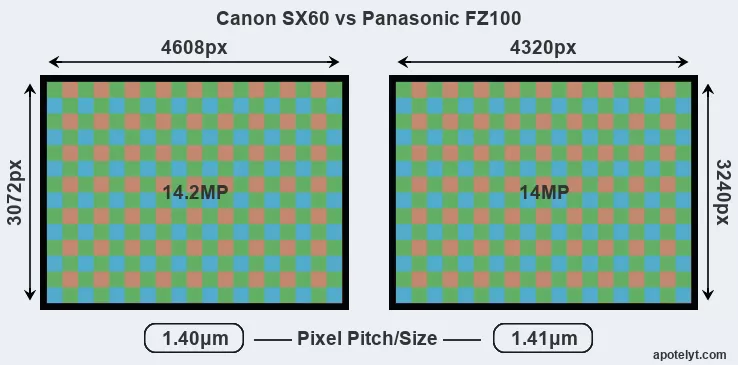
Consistent information on actual sensor performance is available from DXO Mark for many cameras. This service is based on lab testing and assigns an overall score to each camera sensor, as well as ratings for dynamic range ("DXO Landscape"), color depth ("DXO Portrait"), and low-light sensitivity ("DXO Sports"). The following table provides an overview of the physical sensor characteristics, as well as the sensor quality measurements for a selection of comparators.

| Camera Model |
Sensor Class |
Resolution (MP) |
Horiz. Pixels |
Vert. Pixels |
Video Format |
DXO Portrait |
DXO Landscape |
DXO Sports |
DXO Overall |
||
|---|---|---|---|---|---|---|---|---|---|---|---|
| 1. | Canon SX60 | 1/2.3 | 14.2 | 4608 | 3072 | 1080/60p | 19.2 | 10.8 | 127 | 39 | |
| 2. | Panasonic FZ100 | 1/2.3 | 14.0 | 4320 | 3240 | 1080/60i | 19.4 | 10.7 | 306 | 39 | |
| 3. | Canon G1 X Mark II | 1.5-inch | 13.0 | 4160 | 3120 | 1080/30p | 21.5 | 10.8 | 581 | 58 | |
| 4. | Canon G15 | 1/1.7 | 12.0 | 4000 | 3000 | 1080/24p | 19.9 | 11.5 | 165 | 46 | |
| 5. | Canon G16 | 1/1.7 | 12.0 | 4000 | 3000 | 1080/60p | 21.0 | 11.7 | 230 | 54 | |
| 6. | Canon SX30 | 1/2.3 | 14.0 | 4320 | 3240 | 720/30p | 19.4 | 10.7 | 320 | 39 | |
| 7. | Canon SX40 | 1/2.3 | 12.0 | 4000 | 3000 | 1080/24p | 19.6 | 10.9 | 409 | 41 | |
| 8. | Canon SX50 | 1/2.3 | 12.0 | 4000 | 3000 | 1080/24p | 20.3 | 11.2 | 179 | 47 | |
| 9. | Canon SX70 | 1/2.3 | 20.2 | 5184 | 3888 | 4K/30p | 20.6 | 12.1 | 1063 | 51 | |
| 10. | Nikon P900 | 1/2.3 | 15.9 | 4608 | 3456 | 1080/60p | 20.2 | 11.6 | 727 | 47 | |
| 11. | Panasonic FZ150 | 1/2.3 | 12.0 | 4000 | 3000 | 1080/60p | 19.4 | 10.9 | 132 | 40 | |
| 12. | Panasonic FZ200 | 1/2.3 | 12.0 | 4000 | 3000 | 1080/60p | 19.1 | 10.8 | 114 | 37 | |
| 13. | Panasonic FZ300 | 1/2.3 | 12.0 | 4000 | 3000 | 4K/30p | 19.3 | 11.0 | 97 | 38 | |
| 14. | Sony HX400V | 1/2.3 | 20.2 | 5184 | 3888 | 1080/60p | 20.1 | 11.4 | 629 | 45 | |
| Note: DXO values in italics represent estimates based on sensor size and age. | |||||||||||
Many modern cameras are not only capable of taking still images, but can also record movies. Both cameras under consideration are equipped with sensors that have a sufficiently high read-out speed for moving images, but the SX60 provides a higher frame rate than the FZ100. It can shoot video footage at 1080/60p, while the Panasonic is limited to 1080/60i.
Feature comparison
Apart from body and sensor, cameras can and do differ across a variety of features. The two cameras under consideration are similar with respect to both having an electronic viewfinder. However, the one in the SX60 offers a substantially higher resolution than the one in the FZ100 (922k vs 202k dots). The following table reports on some other key feature differences and similarities of the Canon SX60, the Panasonic FZ100, and comparable cameras.

| Camera Model |
Viewfinder (Type or 000 dots) |
Control Panel (yes/no) |
LCD Specifications (inch/000 dots) |
LCD Attach- ment |
Touch Screen (yes/no) |
Max Shutter Speed * |
Max Shutter Flaps * |
Built-in Flash (yes/no) |
Built-in Image Stab |
||
|---|---|---|---|---|---|---|---|---|---|---|---|
| 1. | Canon SX60 | 922 | n | 3.0 / 922 | swivel | n | 1/2000s | 6.4/s | Y | Y | |
| 2. | Panasonic FZ100 | 202 | n | 3.0 / 460 | swivel | n | 1/2000s | 11.0/s | Y | Y | |
| 3. | Canon G1 X Mark II | optional | n | 3.0 / 1040 | tilting | Y | 1/4000s | 5.2/s | Y | Y | |
| 4. | Canon G15 | optical | n | 3.0 / 922 | fixed | n | 1/4000s | 2.1/s | Y | Y | |
| 5. | Canon G16 | optical | n | 3.0 / 922 | fixed | n | 1/4000s | 2.2/s | Y | Y | |
| 6. | Canon SX30 | 202 | n | 2.7 / 230 | swivel | n | 1/3200s | 0.6/s | Y | Y | |
| 7. | Canon SX40 | 202 | n | 2.7 / 230 | swivel | n | 1/3200s | 10.3/s | Y | Y | |
| 8. | Canon SX50 | 202 | n | 3.0 / 461 | swivel | n | 1/2000s | 2.2/s | Y | Y | |
| 9. | Canon SX70 | 2360 | n | 3.0 / 922 | swivel | n | 1/2000s | 10.0/s | Y | Y | |
| 10. | Nikon P900 | 921 | n | 3.0 / 921 | swivel | n | 1/4000s | 7.0/s | Y | Y | |
| 11. | Panasonic FZ150 | 202 | n | 3.0 / 460 | swivel | n | 1/2000s | 12.0/s | Y | Y | |
| 12. | Panasonic FZ200 | 1312 | n | 3.0 / 460 | swivel | n | 1/4000s | 12.0/s | Y | Y | |
| 13. | Panasonic FZ300 | 1440 | n | 3.0 / 1040 | swivel | Y | 1/4000s | 12.0/s | Y | Y | |
| 14. | Sony HX400V | 210 | n | 3.0 / 921 | tilting | n | 1/4000s | 10.0/s | Y | Y | |
| Note: *) Information refers to the mechanical shutter, unless the camera only has an electronic one. | |||||||||||
Both the SX60 and the FZ100 have zoom lenses built in. The SX60 has a 21-1365mm f/3.4-6.5 optic and the FZ100 offers a 25-600mm f/2.8-5.2 (focal lengths in full frame equivalent terms). Hence, the Canon provides a wider angle of view at the short end, as well as more tele-photo reach at the long end than the Panasonic. The FZ100 offers the faster maximum aperture.
Concerning the storage of imaging data, both the SX60 and the FZ100 write their files to SDXC cards.
Connectivity comparison
For some imaging applications, the extent to which a camera can communicate with its environment can be an important aspect in the camera decision process. The table below provides an overview of the connectivity of the Canon PowerShot SX60 HS and Panasonic Lumix DMC-FZ100 and, in particular, the interfaces the cameras (and selected comparators) provide for accessory control and data transfer.

| Camera Model |
Hotshoe Port |
Internal Mic / Speaker |
Microphone Port |
Headphone Port |
HDMI Port |
USB Port |
WiFi Support |
NFC Support |
Bluetooth Support |
||
|---|---|---|---|---|---|---|---|---|---|---|---|
| 1. | Canon SX60 | Y | stereo / mono | Y | - | mini | 2.0 | Y | Y | - | |
| 2. | Panasonic FZ100 | Y | stereo / mono | - | - | mini | 2.0 | - | - | - | |
| 3. | Canon G1 X Mark II | Y | stereo / mono | - | - | mini | 2.0 | Y | Y | - | |
| 4. | Canon G15 | Y | stereo / mono | - | - | mini | 2.0 | - | - | - | |
| 5. | Canon G16 | Y | stereo / mono | - | - | mini | 2.0 | Y | - | - | |
| 6. | Canon SX30 | Y | stereo / mono | - | - | YES | 2.0 | - | - | - | |
| 7. | Canon SX40 | Y | stereo / mono | - | - | YES | 2.0 | - | - | - | |
| 8. | Canon SX50 | Y | stereo / mono | - | - | mini | 2.0 | - | - | - | |
| 9. | Canon SX70 | - | stereo / mono | Y | - | micro | 2.0 | Y | - | Y | |
| 10. | Nikon P900 | - | stereo / mono | - | - | micro | 2.0 | Y | Y | - | |
| 11. | Panasonic FZ150 | Y | stereo / - | - | - | mini | 2.0 | - | - | - | |
| 12. | Panasonic FZ200 | Y | stereo / mono | Y | - | mini | 2.0 | - | - | - | |
| 13. | Panasonic FZ300 | Y | stereo / mono | Y | - | mini | 2.0 | Y | - | - | |
| 14. | Sony HX400V | Y | stereo / mono | - | - | micro | 2.0 | Y | Y | - |
It is notable that the SX60 has a microphone port, which is missing on the FZ100. Such an external microphone input can help to substantially improve the quality of audio recordings when a good external microphone is used.
Both the SX60 and the FZ100 have been discontinued, but can regularly be found used on ebay. The FZ100 was replaced by the Panasonic FZ150, while the SX60 was followed by the Canon SX70. Further information on the features and operation of the SX60 and FZ100 can be found, respectively, in the Canon SX60 Manual (free pdf) or the online Panasonic FZ100 Manual.
Review summary
So what conclusions can be drawn? Is there a clear favorite between the Canon SX60 and the Panasonic FZ100? Which camera is better? A synthesis of the relative strong points of each of the models is listed below.

Reasons to prefer the Canon PowerShot SX60 HS:
- Better video: Provides higher movie framerates (1080/60p versus 1080/60i).
- Better sound: Can connect to an external microphone for higher quality sound recording.
- More detailed viewfinder: Has higher resolution electronic viewfinder (922k vs 202k dots).
- More detailed LCD: Has a higher resolution rear screen (922k vs 460k dots).
- Wider view: Has a wider-angle lens that facilitates landscape or interior shots.
- More tele-reach: Has a longer tele-lens for perspective compression and subject magnification.
- Easier file upload: Has wifi built in for automatic backup or image transfer to the web.
- Easier device pairing: Supports NFC for fast wireless image transfer over short distances.
- More modern: Reflects 4 years and 1 month of technical progress since the FZ100 launch.

Arguments in favor of the Panasonic Lumix DMC-FZ100:
- Faster burst: Shoots at higher frequency (11 vs 6.4 flaps/sec) to capture the decisive moment.
- Better light gathering: Has a lens with a wider maximum aperture (f/2.8 vs f/3.4).
- More compact: Is smaller (124x82mm vs 128x93mm) and will fit more readily into a bag.
- Less heavy: Has a lower weight (by 110g or 17 percent) and is thus easier to take along.
- Longer lasting: Gets more shots (410 versus 340) out of a single battery charge.
- More heavily discounted: Has been around for much longer (launched in July 2010).
If the count of individual advantages (bullet points above) is taken as a guide, the SX60 emerges as the winner of the contest (9 : 6 points). However, the relevance of individual strengths will vary across photographers, so that you might want to apply your own weighing scheme to the summary points when reflecting and deciding on a new camera. A professional wildlife photographer will view the differences between cameras in a way that diverges from the perspective of a family photog, and a person interested in architecture has distinct needs from a sports shooter. Hence, the decision which camera is best and worth buying is often a very personal one.
How about other alternatives? Do the specifications of the Canon SX60 and the Panasonic FZ100 place the cameras among the top in their class? Find out in the latest Best Superzoom Camera listing whether the two cameras rank among the cream of the crop.
In any case, while the comparison of the spec-sheets of cameras can offer a general idea of their imaging potential, it remains partial and cannot reveal, for example, the shooting experience and imaging performance when actually working with the SX60 or the FZ100. User reviews, such as those found at amazon, can sometimes inform about these issues, but such feedback is often incomplete, inconsistent, and biased.
Expert reviews
This is why hands-on reviews by experts are important. The table below provides a synthesis of the camera assessments of some of the best known photo-gear review sites (amateurphotographer [AP], cameralabs [CL], digitalcameraworld [DCW], dpreview [DPR], ephotozine [EPZ], photographyblog [PB]). As can be seen, the professional reviewers agree in many cases on the quality of different cameras, but sometimes their assessments diverge, reinforcing the earlier point that a camera decision is often a very personal choice.

| Camera Model |
AP score |
CL score |
DCW score |
DPR score |
EPZ score |
PB score |
Camera Launch |
Launch Price (USD) |
Street Price |
||
|---|---|---|---|---|---|---|---|---|---|---|---|
| 1. | Canon SX60 | 3/5 | + + | .. | 75/100 | 4/5 | 4.5/5 | Sep 2014 | 549 | ebay.com | |
| 2. | Panasonic FZ100 | .. | + | .. | .. | 4.5/5 | 4.5/5 | Jul 2010 | 499 | ebay.com | |
| 3. | Canon G1 X Mark II | 3/5 | + | .. | 77/100 | 4/5 | 4.5/5 | Feb 2014 | 799 | ebay.com | |
| 4. | Canon G15 | 4/5 | + | .. | 76/100 | 4.5/5 | 4.5/5 | Sep 2012 | 499 | ebay.com | |
| 5. | Canon G16 | 4/5 | + | .. | .. | 4.5/5 | 4.5/5 | Aug 2013 | 549 | ebay.com | |
| 6. | Canon SX30 | 3/5 | + + | .. | .. | 3.5/5 | 4/5 | Sep 2010 | 429 | ebay.com | |
| 7. | Canon SX40 | .. | + | .. | .. | 4.5/5 | 4/5 | Sep 2011 | 429 | ebay.com | |
| 8. | Canon SX50 | 3/5 | + + | .. | 72/100 | 4.5/5 | 4.5/5 | Sep 2012 | 429 | ebay.com | |
| 9. | Canon SX70 | .. | + + | 3.5/5 | .. | 3.5/5 | 3.5/5 | Sep 2018 | 549 | amazon.com | |
| 10. | Nikon P900 | .. | .. | .. | 77/100 | 4/5 | 4/5 | Mar 2015 | 599 | ebay.com | |
| 11. | Panasonic FZ150 | 3/5 | + + | .. | 76/100 | 4/5 | 4.5/5 | Aug 2011 | 499 | ebay.com | |
| 12. | Panasonic FZ200 | 3/5 | + + | .. | 80/100 | 4.5/5 | 4.5/5 | Jul 2012 | 599 | ebay.com | |
| 13. | Panasonic FZ300 | .. | + + | .. | .. | 4.5/5 | 4.5/5 | Jul 2015 | 599 | amazon.com | |
| 14. | Sony HX400V | 4/5 | + + | .. | .. | 4/5 | 4/5 | Feb 2014 | 499 | ebay.com | |
| Note: (+ +) highly recommended; (+) recommended; (o) reviewed; (..) not available. | |||||||||||
Care should be taken when interpreting the review scores above, though. The assessments were made in relation to similar cameras of the same technological generation. Thus, a score needs to be put into the context of the launch date and the launch price of the camera, and comparisons of ratings among very different cameras or across long time periods have little meaning. Also, kindly note that some of the listed sites have over time developped their review approaches and their reporting style.

Check SX60 offers at
ebay.com

Check FZ100 offers at
ebay.com
Other camera comparisons
Did this review help to inform your camera decision process? In case you would like to check on the differences and similarities of other camera models, just make your choice using the following search menu. There is also a set of direct links to comparison reviews that other users of the CAM-parator app explored.
- Canon 1200D vs Canon SX60
- Canon G16 vs Canon SX60
- Canon M6 vs Panasonic FZ100
- Canon SX60 vs Canon XS
- Canon SX60 vs Nikon D3000
- Canon SX60 vs Nikon L840
- Canon SX60 vs Sony A68
- Fujifilm X-H1 vs Panasonic FZ100
- Fujifilm X-Pro2 vs Panasonic FZ100
- Leica SL vs Panasonic FZ100
- Nikon D3500 vs Panasonic FZ100
- Panasonic FZ100 vs Sony A900
Specifications: Canon SX60 vs Panasonic FZ100
Below is a side-by-side comparison of the specs of the two cameras to facilitate a quick review of their differences and common features.
| Camera Model | Canon SX60 | Panasonic FZ100 |
|---|---|---|
| Camera Type | Fixed lens compact camera | Fixed lens compact camera |
| Camera Lens | 21-1365mm f/3.4-6.5 | 25-600mm f/2.8-5.2 |
| Launch Date | September 2014 | July 2010 |
| Launch Price | USD 549 | USD 499 |
| Sensor Specs | Canon SX60 | Panasonic FZ100 |
| Sensor Technology | BSI-CMOS | CMOS |
| Sensor Format | 1/2.3" Sensor | 1/2.3" Sensor |
| Sensor Size | 6.17 x 4.55 mm | 6.17 x 4.55 mm |
| Sensor Area | 28.0735 mm2 | 28.0735 mm2 |
| Sensor Diagonal | 7.7 mm | 7.7 mm |
| Crop Factor | 5.6x | 5.6x |
| Sensor Resolution | 14.2 Megapixels | 14 Megapixels |
| Image Resolution | 4608 x 3072 pixels | 4320 x 3240 pixels |
| Pixel Pitch | 1.40 μm | 1.41 μm |
| Pixel Density | 50.42 MP/cm2 | 49.86 MP/cm2 |
| Moiré control | no AA filter | no AA filter |
| Movie Capability | 1080/60p Video | 1080/60i Video |
| ISO Setting | 100 - 3,200 ISO | 100 - 1,600 ISO |
| ISO Boost | 100 - 6,400 ISO | 100 - 6,400 ISO |
| Image Processor | DIGIC 6 | Venus FHD |
| DXO Sensor Quality (score) | 39 | .. |
| DXO Color Depth (bits) | 19.2 | .. |
| DXO Dynamic Range (EV) | 10.8 | .. |
| DXO Low Light (ISO) | 127 | .. |
| Screen Specs | Canon SX60 | Panasonic FZ100 |
| Viewfinder Type | Electronic viewfinder | Electronic viewfinder |
| Viewfinder Field of View | 100% | 100% |
| Viewfinder Resolution | 922k dots | 202k dots |
| LCD Framing | Live View | Live View |
| Rear LCD Size | 3.0inch | 3.0inch |
| LCD Resolution | 922k dots | 460k dots |
| LCD Attachment | Swivel screen | Swivel screen |
| Shooting Specs | Canon SX60 | Panasonic FZ100 |
| Focus System | Contrast-detect AF | Contrast-detect AF |
| Manual Focusing Aid | Focus Peaking | no Peaking Feature |
| Continuous Shooting | 6.4 shutter flaps/s | 11 shutter flaps/s |
| Fill Flash | Built-in Flash | Built-in Flash |
| Storage Medium | SDXC cards | SDXC cards |
| Single or Dual Card Slots | Single card slot | Single card slot |
| UHS card support | no | no |
| Connectivity Specs | Canon SX60 | Panasonic FZ100 |
| External Flash | Hotshoe | Hotshoe |
| USB Connector | USB 2.0 | USB 2.0 |
| HDMI Port | mini HDMI | mini HDMI |
| Microphone Port | External MIC port | no MIC socket |
| Wifi Support | Wifi built-in | no Wifi |
| Near-Field Communication | NFC built-in | no NFC |
| Body Specs | Canon SX60 | Panasonic FZ100 |
| Battery Type | Canon NB-10L | Panasonic DMW-BMB9 |
| Battery Life (CIPA) | 340 shots per charge | 410 shots per charge |
| Body Dimensions |
128 x 93 x 114 mm (5.0 x 3.7 x 4.5 in) |
124 x 82 x 92 mm (4.9 x 3.2 x 3.6 in) |
| Camera Weight | 650 g (22.9 oz) | 540 g (19.0 oz) |

Check SX60 offers at
ebay.com

Check FZ100 offers at
ebay.com
Did you notice an error on this page? If so, please get in touch, so that we can correct the information.

